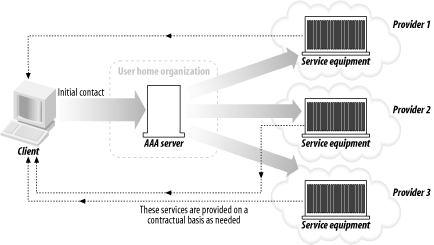Distributed Services
Now consider a situation in which a service provider contracts with numerous wholesalers to provide services to its user base. For example, a provider could guarantee a certain amount of bandwidth across the country for a particular company. The frontline ISP with which the company, as a client, contracts needs to set a QoS policy on equipment across the country to maintain its contractual duty to the customer. The customer, in this situation, is using a distributed service. Figure 1-9 illustrates this.
 |
In Figure 1-9, we make the assumption that the user first contacts his UHO and gains authorization from its servers, which then provision his service from the other organizations involved in his contract. But this is not necessarily the case. The contacts between the equipment at the first and second organizations can use any of the three authorization sequences we described earlier. For instance, the user can contact the service equipment in the first hop, using the pull authorization sequence. Following that, the ISP’s equipment will use a push sequence: it will contact the AAA server at the second organization, obtain authorization, and push the service equipment. This process can be carried out as many times as necessary to fulfill the frontline ISP’s contractual obligations. Figure 1-10 demonstrates this type of distributed ...
Get RADIUS now with the O’Reilly learning platform.
O’Reilly members experience books, live events, courses curated by job role, and more from O’Reilly and nearly 200 top publishers.

